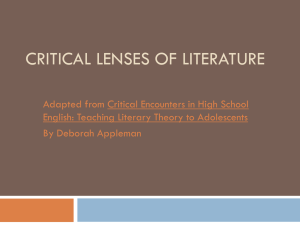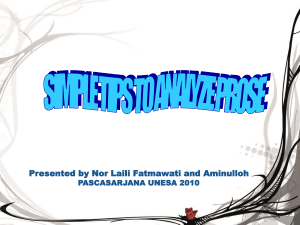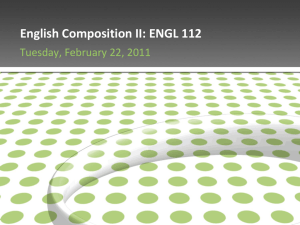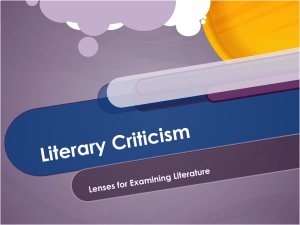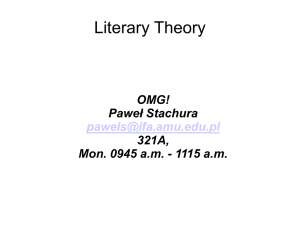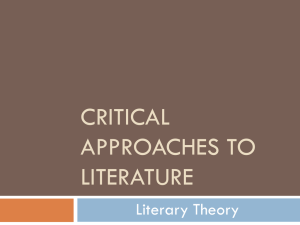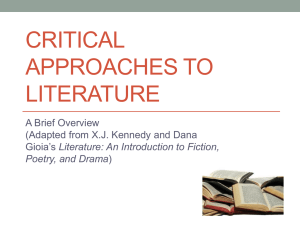BIBLICAL EXEGESIS
advertisement
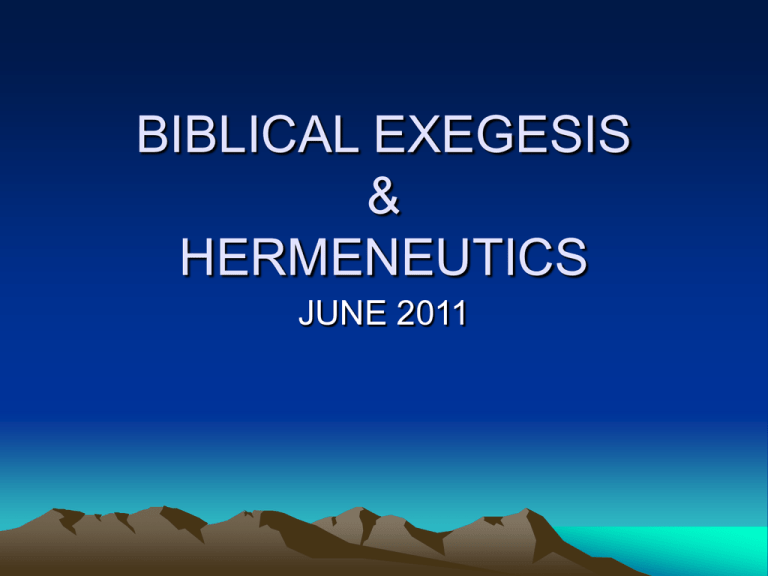
BIBLICAL EXEGESIS & HERMENEUTICS JUNE 2011 Key Terms • Exegesis—process by which the (original) meaning/sense of text is established. • Hermeneutics—the grammar, logic, or rules on the basis of which an interpretation is executed. • Exegesis is related to Hermeneutics as Language is to Grammar Biblical Criticism • Historical Criticism—get behind the written text to an earlier oral and/or written form. Recapture earliest form and establish intended meaning of original author(s). • Narrative Criticism—accepts text in final form; asks what it communicates to its readers in current form. Biblical Criticism • “Parable of the Three Hikers” (Trespassers will be persecuted!) • AUTHORTEXTREADER – Where is meaning located? 1. Is that what the author intended? 2. “It means just what it says!” 3. Relevant? Significant? Impact on this world? Biblical Criticism Historical Criticism—complex weave of oral traditions, written sources, and editorial efforts. 20th century shift to the “world in the text” and the text’s effective presence in the contemporary world (or the “world in front of the text”). Map • Historical Criticism – Textual-retrieves original wording when manuscripts differ because of scribal changes – Source-reconstructs older written documents incorporated piecemeal into present texts. – Redaction-reveals ways in which editors overlay their interpretations in the course of rearranging and transmitting. – Form Map • Literary Criticism – Close Reading – Structuralism – Narrative Criticism – Rhetorical Criticism – Reader-Response Criticism Map • Ideological Criticism – Feminist criticism – African American criticism – Hispanic, Latino/a Criticism – Liberation Exegesis – Postcolonial criticism Narrative Criticism: Two Principles • Narrative texts are designed to evoke a response from the reader. Beyond the intellect, narratives appeal to emotion and will, compelling the reader to make moral judgments about characters and the values that are at work in a story. • Readers are not completely at the will of the authors. We bring our personal and communal histories to the act of reading. These factors influence our response to the stories. LISTEN! • Do not learn a catalogue of narrative techniques, search for their presence in the text, and then decide what response the author intended to produce in the reader. – That is not reading! Let yourself be moved by the narrative power of the text, by the Spirit of Life that animates engagement, intelligence, and action. Biblical Interpretation in the Early Church • • • • • Christ the Key Christ is the End of the Law and the Prophets Intensive Reading Typological Reading Allegorical Reading Ignatius of Antioch • “To my mind it is Jesus Christ who is the original documents. The inviolable archives are his cross and death and his resurrection and the faith that came by him” – Single most important feature of patristic exegesis: knowing the identity of Jesus the Messiah is the basis for the right reading of the sacred writings of Israel. Didymus the Blind (Alexandrian School) • Genesis 12:1— “….go from your country and your kindred and your father’s house to the land I will show you…” (literal sense) Evil spirits afflict those committed to pursuing righteousness, and so God rightly calls them to ‘come out.’ Luke 14:26; Mark 10:28 (“left everything”); Psalm 45:10-11 Verbal Similarities and Common Patterns (series and formulas): each instance builds up and reinforces formal pattern: TURN AWAY FROM EVIL AND TOWARD HEAVENLY TRUTH. Irenaeus • Popular title: Against Heresies (Valentinians) • Borrows three terms from ancient rhetoric: – Hypothesis – Economy – Recapitulation Irenaeus • Hypothesis—the gist of any work (of literature). Taken as a whole, the work of God holds together best when seen as…? • Heretical interpretations are fundamentally flawed at just this level: they fail to identify the correct hypothesis of the Bible. – (Mosaic) Irenaeus • Economy (oikonomia)—right order and arrangement of affairs. A story should have an economy, a structure or plot that allows us to discern the flow of the narrative. (Heretics are imposing a false economy or false order upon Scripture) – “We hold fast to the rule of truth, that there is one almighty God who founded everything through his Word and arranged it and made everything out of the non-existent.” Economy and Recapitulation • The divinely arranged economy is necessary for understanding any event or episode of Scripture. (2,4,6,8…) • But Jesus Christ is not simply one member of this divine outline or sequence, but the final repetition, the drawing to a close, the summing up of the entire sequence. Recapitulation • The recapitulation of all things in Christ fills in the gaps and resolves the inconclusive patterns evident throughout biblical history. – Death came by way of the fruit of a tree, not simply an abstract “fall.” Jesus Christ recapitulates this scene, although in key of righteousness rather than sin (tree of the cross). Other Patristic Approaches • Intensive Reading-lexical and associative strategies (key terms) • Typological Reading-Christ as antitypos (Hebrews 9:24; 1 Peter 3:21); Old Adam/New Adam – “prefigurations” and “postfigurations” • Allegorical Reading – Typology and Allegory belong to same family of reading strategies; only differ in extent of interpretive demands. Old Testament Narrative June 2011 Tentmakers DYNAMICS OF NARRATIVE • Innermost box Story/Plot (characters, events, settings); “secondary world” • Second box Narrative; narrator tells the story to the narratee. Story took place in the past. • Outermost box Text; “primary world” in which the written text is in our hands. “Implied author” and “implied reader.”
